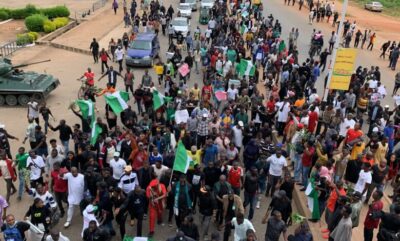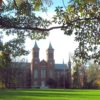In September of 2013, a year’s worth of rain fell on Boulder County and the surrounding region over a four-day period. This was called a 1,000-year rainfall event and it flooded every major drainage along the Front Range, killing a number people and causing hundreds of millions of dollars in damages. As is the case in every disaster, its effects were distributed unevenly across different households and communities in the region, but its exact impacts were unpredictable. Uncertainty is a central element of disaster risk and, according to much of popular and academic discourse, one of the defining features of late capitalism and the Anthropocene. Taking advantage of the interdisciplinary character of the issue, I want to suggest expanding our suite of tools for approaching the question of uncertainty. Building on Samimian-Darash and Rabinow,1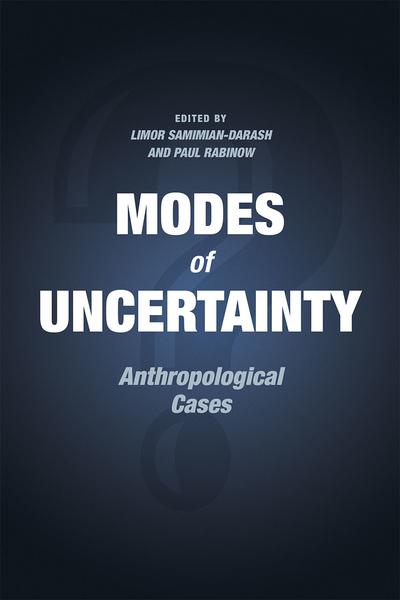 Chicago: University of Chicago Press, 2015More Info → I use the case of the 2013 Colorado floods to argue that there are at least three distinct “modes of uncertainty” we can draw upon when determining how to engage with the challenges presented by disaster risk and climate change.
Chicago: University of Chicago Press, 2015More Info → I use the case of the 2013 Colorado floods to argue that there are at least three distinct “modes of uncertainty” we can draw upon when determining how to engage with the challenges presented by disaster risk and climate change.
My research examines the information systems we use to understand and respond to environmental hazards including floods, earthquakes, and sea-level rise. In particular, I try to understand how these systems have come to be as they are, how the particulars of their construction shape our understanding of the environment, with what consequence, and how things might be different. I use qualitative and design research methods and draw on human-centered computing, information science, and science and technology studies, as well as my own professional background as a software developer and cartographer. In my research and consulting practice I spend a lot of time working within a techno-scientific mode of thinking about uncertainty as it relates to disaster risk management—as a problem to be minimized or worked around. I will discuss this mode but also two others that I have more recently been learning to think with—uncertainty as generative and uncertainty as systematically produced.
To ground this discussion I draw from research colleagues at the University of Colorado Boulder (CU) and I conducted on the information standard that underpins the US National Flood Insurance Program (NFIP) maps—the 100-year floodplain.2Robert Soden, Leah Sprain, and Leysia Palen, “Thin Grey Lines: Confrontations with Risk on Colorado’s Front Range” (ACM CHI Conference on Human Factors in Computing Systems, Denver, CO, May 2017). This standard plays an important role both in how the federal government attempts to manage flood risk across a large and heterogeneous territory but also in the popular imagination of flood danger. As part of this study, I spent a year conducting research at a large engineering firm contracted by FEMA to update flood maps for the State of Colorado in the wake of the 2013 floods.
While there I assisted in various tasks related to data preparation and map production, looked over the shoulder of experienced engineers as they went about their work, and interviewed many of the firm’s employees about their perspectives on the process. At the same time, my colleagues at CU and I were interviewing members of the public about their understandings of flood risk and the floodplain maps. Based on the data collected through this process we argue that the 100-year standard, by presenting flood risk in a binary fashion (one is either in the floodplain or out of it), represents a problematic form of discursive closure in scientific understanding of flood hazard. We show how this closure serves to convey a certainty that the underlying science does not warrant and foreshortens public understanding of flood hazard in the region. We then looked at design opportunities for resisting this closure and helping the public develop a more engaged understanding of flood hazard.
Mode 1: Techno-science
The first, most familiar, mode of thinking about uncertainty frames it as a problem to overcome through advances in science and technology. The promise of the Enlightenment, after all, was the triumph of reason over nature. Yet it’s been widely argued that this effort will always come up short. Hume’s skepticism, for example, is rooted in his argument that all scientific claims are underdetermined, that they will always fail to take into account a functionally infinite number of potential states of the world. For many scholars, an asymptotic pursuit of certainty is in fact one of the defining characteristics of modernity.3→Ulrich Beck, Risk Society: Towards a New Modernity (Thousand Oaks, CA, and London: Sage, 1992).
→Matthew Gandy, The Fabric of Space: Water, Modernity, and the Urban Imagination (Cambridge, MA: The MIT Press, 2014).
→Stephen Toulmin, Cosmopolis: The Hidden Agenda of Modernity (Chicago: The University of Chicago Press, 1992). Despite the ways in which quantum physics has complicated the issue4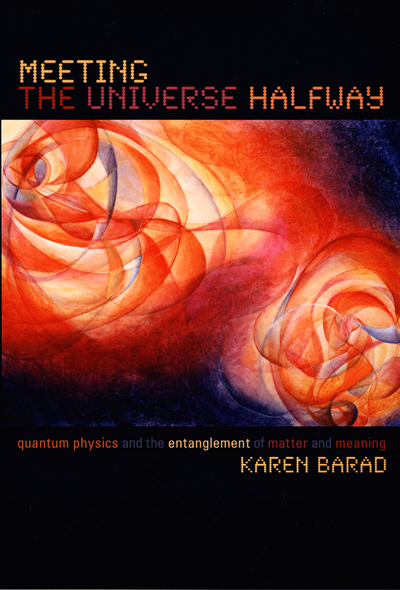 Durham, NC: Duke University Press, 2007More Info → and increased attention to so-called “wicked problems,” this perspective continues to guide scientists and technologists working in my field sites.
Durham, NC: Duke University Press, 2007More Info → and increased attention to so-called “wicked problems,” this perspective continues to guide scientists and technologists working in my field sites.
Complex taxonomies of uncertainties are produced and used to identify tactics for managing or eliminating them.5Richard Bradley and Mareile Drechsler, “Types of Uncertainty,” Erkenntnis 79, no. 6 (2014): 1225–1248; David Spiegelhalter and Hauke Riesch, “Don’t Know, Can’t Know: Embracing Scientific Uncertainty When Analyzing Risks,” Philosophical Transactions of the Royal Society A: Mathematical, Physical and Engineering Sciences 369, no. 1956 (2011); Brian Wynne, “Uncertainty and Environmental Learning: Reconceiving Science and Policy in the Preventive Paradigm,” Global Environmental Change 2, no. 2 (1992): 111–127. Better sensors, higher-resolution data, and more powerful algorithms will yield flood maps with less uncertainty. Sophisticated approaches to data visualization and risk communication will help the public navigate the remainder. To date, this has been the dominant mode of dealing with uncertainty in science and science communication.
“The lines on the flood map, intended to delineate a 1 percent annual chance of flooding, were taken as indicators of complete safety in the public imagination.”Our research in Boulder showed that residents who lived outside of the floodplain were unprepared for the possibility that their homes could experience flooding during the storm. Few bought insurance or took other protective measures. The lines on the flood map, intended to delineate a 1 percent annual chance of flooding, were taken as indicators of complete safety in the public imagination. Furthermore, the regulatory and insurance implications for property mapped inside the flood hazard zone, as well as the impact on real estate values, have turned flood mapping into an intensely politicized processes, where homeowners with the resources to engage can tie up map updates in public comment processes that stretch on for months or years. At present, some 60 percent of NFIP-rated maps are thought to be out of date due in part to such debates. Though we can imagine alternative data standards that would present more complex understandings of flood risk, some level of uncertainty will always remain. For example, during the flooding, everything from debris and small landslides in the canyons above Boulder to landscaping to attempts by residents to build makeshift defenses channeled the floodwater in unpredictable directions. Despite possible improvements in the science and technology of flood mapping, Hume’s warning about the underdetermination of scientific claims will always be with us. So, let’s look at some other ways to approach the question.
Mode 2: Uncertainty as generative
Another mode of addressing uncertainty that is gaining traction in some design and STS circles is to treat it as something generative, or productive, rather than a problem to be isolated, reduced, and managed. For Pink, Akama, and Sumartojo, uncertainty is a “technology” that can be usefully disruptive in overly determined contexts, allowing creativity and speculative practice to flourish in the cracks.6 London: Bloomsbury Publishing, 2018More Info → Similarly, Gaver, Beaver, and Benford write that ambiguity, an allied concept, supports “deep appropriation” of ideas and technologies: “By impelling people to interpret situations for themselves, it encourages them to start grappling conceptually with systems and their contexts, and thus to establish deeper and more personal relations with the meanings offered by those systems.”7William Gaver, Jacob Beaver, and Steve Benford, “Ambiguity as a Resource for Design” (ACM CHI Conference on Human Factors in Computing Systems, Ft. Lauderdale, FL, April 2003). In this mode, uncertainty is not located in technologies of representation (e.g., maps, models, databases) but rather emerges in particular settings and during particular moments. We thus can seek to design encounters that allow the possibility for uncertainty to emerge in useful ways.
London: Bloomsbury Publishing, 2018More Info → Similarly, Gaver, Beaver, and Benford write that ambiguity, an allied concept, supports “deep appropriation” of ideas and technologies: “By impelling people to interpret situations for themselves, it encourages them to start grappling conceptually with systems and their contexts, and thus to establish deeper and more personal relations with the meanings offered by those systems.”7William Gaver, Jacob Beaver, and Steve Benford, “Ambiguity as a Resource for Design” (ACM CHI Conference on Human Factors in Computing Systems, Ft. Lauderdale, FL, April 2003). In this mode, uncertainty is not located in technologies of representation (e.g., maps, models, databases) but rather emerges in particular settings and during particular moments. We thus can seek to design encounters that allow the possibility for uncertainty to emerge in useful ways.
As part of our exploration of the 100-year floodplain standard in Boulder, we undertook two very simple experiments on how to design encounters with flood risk information that would be more engaging. The first relied on “serious games” to support collective questioning and discovery of flood risk. Participants, working together in small teams, were given various types of flood information and then deliberated over various flood protection measures, coming to new insights and understanding through their debates and discussions. This approach contrasts what we observed to be most Boulder residents’ experience of flood data, if any, which concerned whether an individual’s home was inside the flood hazard zone or not. The second experiment used what is called frictional design8Matthias Korn and Amy Voida, “Creating Friction: Infrastructuring Civic Engagement in Everyday Life,” in Proceedings of the Fifth Decennial Aarhus Conference on Critical Alternatives (Aarhus University Press, 2015), 145–156. to complicate flood maps by adding other kinds of risk information, most notably the extents of past flood events. Here, simply showing residents that previous flooding had affected areas outside of the flood hazard zone generated deeper engagement in the form of questions about how the maps are produced and what exactly they are meant to convey.
Uncertainty in these examples became an invitation for the public to look closer and promises rewards in the form of more in-depth understanding of the complex and collective aspects of flood danger. Rather than a problem to be solved, approaching uncertainty in this mode positions it as a resource that can be drawn upon, where appropriate, to support communication, education, or public participation in risk management.9This responds to Anna Tsing’s call to cultivate the “arts of noticing” in a period characterized by increasing disruption and turbulence. The Mushroom at the End of the World: On the Possibility of Life in Capitalist Ruins (Princeton, NJ: Princeton University Press, 2015). By staging encounters with uncertainty as an opportunity to provoke speculation, curiosity, or deep engagement, our field can help cope with, and even benefit from, uncertainty in cases where it is impossible, or would be undesirable, to fully eliminate it.
Mode 3: Systematically produced
Third, we should ask about the ways in which uncertainty, as an object of knowledge, is systematically produced, or a result of particular historical constellations of ideology and power. In this mode, uncertainty is neither seen as a problem to be addressed or a resource to be leveraged, but instead the target of questions such as:10→Michelle Murphy, Sick Building Syndrome and the Problem of Uncertainty: Environmental Politics, Technoscience, and Women Workers (Durham, NC: Duke University Press, 2006).
→Brian Wynne, “Sheepfarming after Chernobyl: A Case Study in Communicating Scientific Information,” Environment: Science and Policy for Sustainable Development 31, no. 2 (1989): 10–39.
- How do the answers to some questions become seen as uncertain and in need of greater evidence?
- How is it that other potential uncertainties are not found problematic?
- How do political interests, such as those of the fossil fuel industry, deploy uncertainty strategically in order to influence policy around issues like climate change or regulations on real estate development?
- How does scientific and technical expertise privilege the study of some forms of uncertainty over others?
Here we might also look to an emerging body of work on agnotology, which is gaining attention in STS and anthropology.11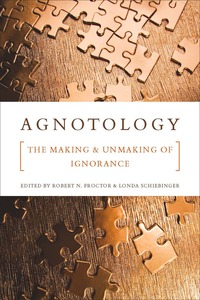 Redwood City, CA: Stanford University Press, 2008More Info → Agnotology explores the social and political construction of ignorance in ways that are similar to this third mode of thinking about uncertainty. We may be able to draw upon this area of work to support and clarify our own thinking.
Redwood City, CA: Stanford University Press, 2008More Info → Agnotology explores the social and political construction of ignorance in ways that are similar to this third mode of thinking about uncertainty. We may be able to draw upon this area of work to support and clarify our own thinking.
In the case of flooding, this third mode might lead us to ask why we focus more on some uncertainties, like how much rain will fall and where will it go over a given time period, while giving less attention (and research funding) to questions around the structural factors that yield certain kinds of vulnerabilities to flooding, or limit some groups’ ability to recover in the aftermath.12Andrew Rumbach et al., Understanding Household Recovery following the Colorado Flash Floods (Quick Response Report series, Natural Hazards Center, University of Colorado, 2013). This perspective might lead us to focus on the uncertainty of different issues, for example, by asking questions about the probability of residents’ ability to return to their homes following a major disaster, as one study related to earthquakes in San Francisco recently did.13San Francisco Bay Area Planning and Urban Research Association, Safe Enough to Stay (San Francisco: SPUR, 2012). It might also mean moving even further away from “solving” uncertainty from a technical perspective and toward a fuller critique of how uncertainty appears in our sites of research and practice, with what effects, and at the expense of whose interests.
Conclusion
Flood management efforts would benefit from greater attention to how we think about uncertainty. The term is currently used, even within the same fields, to refer to many different kinds of phenomena. Such conceptual overloading reduces the tools that we have for thinking about the various sorts of uncertainties that arise in our work. Here I’ve argued that there are at least two modes of engaging with uncertainty that are distinct from the techno-scientific conception that typically prevails. This is not to say that further attempts to collect better data, develop better algorithms, or do better science aren’t important, but that such efforts to address questions of uncertainty in our research and practice would benefit from a much richer conceptual apparatus to work with. So, in addition to bringing these other modes to bear more frequently on our work in disaster risk, part of this work will also be to develop a facility for moving between these modes, knowing when and how it might be profitable to deploy one versus another.
References:
→Matthew Gandy, The Fabric of Space: Water, Modernity, and the Urban Imagination (Cambridge, MA: The MIT Press, 2014).
→Stephen Toulmin, Cosmopolis: The Hidden Agenda of Modernity (Chicago: The University of Chicago Press, 1992).
→Brian Wynne, “Sheepfarming after Chernobyl: A Case Study in Communicating Scientific Information,” Environment: Science and Policy for Sustainable Development 31, no. 2 (1989): 10–39.











